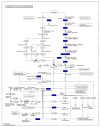Genomic, Molecular, and Phenotypic Characterization of Arthrobacter sp. OVS8, an Endophytic Bacterium Isolated from and Contributing to the Bioactive Compound Content of the Essential Oil of the Medicinal Plant Origanum vulgare L
- PMID: 36902273
- PMCID: PMC10002853
- DOI: 10.3390/ijms24054845
Genomic, Molecular, and Phenotypic Characterization of Arthrobacter sp. OVS8, an Endophytic Bacterium Isolated from and Contributing to the Bioactive Compound Content of the Essential Oil of the Medicinal Plant Origanum vulgare L
Abstract
Medicinal plants play an important role in the discovery of new bioactive compounds with antimicrobial activity, thanks to their pharmacological properties. However, members of their microbiota can also synthesize bioactive molecules. Among these, strains belonging to the genera Arthrobacter are commonly found associated with the plant's microenvironments, showing plant growth-promoting (PGP) activity and bioremediation properties. However, their role as antimicrobial secondary metabolite producers has not been fully explored. The aim of this work was to characterize the Arthrobacter sp. OVS8 endophytic strain, isolated from the medicinal plant Origanum vulgare L., from molecular and phenotypic viewpoints to evaluate its adaptation and influence on the plant internal microenvironments and its potential as a producer of antibacterial volatile molecules (VOCs). Results obtained from the phenotypic and genomic characterization highlight its ability to produce volatile antimicrobials effective against multidrug-resistant (MDR) human pathogens and its putative PGP role as a producer of siderophores and degrader of organic and inorganic pollutants. The outcomes presented in this work identify Arthrobacter sp. OVS8 as an excellent starting point toward the exploitation of bacterial endophytes as antibiotics sources.
Keywords: endophytes; essential oil; genome; plant microbiota; volatile organic compounds.
Conflict of interest statement
The authors declare no conflict of interest.
Figures





References
-
- Govind P. Medicinal plants against liver diseases. Int. Res. J. Pharm. 2011;2:115–121.
-
- Saxena S. Role of medicinal plants in neurodegenerative diseases. J. Int. Med. Sci. Acad. 2015;28:218–221. doi: 10.1007/s40898-017-0004-7. - DOI
MeSH terms
Substances
LinkOut - more resources
Full Text Sources
Molecular Biology Databases
Miscellaneous

